Nathaniel Walton
of
Preston, Norwich,
and Griswold, Connecticut

Nathaniel Walton, the second oldest son of Lawrence and Margaret (Smith) Walton, was born 20 March 1697 in Preston, Connecticut. He married Jemima (__) about 1716, and from all accounts settled on the land his father deeded to him in 1725 for his entire life. He and Jemima had six known children, born between 1717 and 1750 (Canterbury Vital Records, 1696-1820; Norwich Vital Records, 1640-1834; Connecticut Probate Records, 1609-1999):
-
Lawrence Walton, born 15 December 1717 at Canterbury, Connecticut (Canterbury Vital Records, 1696-1820)[i]; married Deborah (__) (Norwich Vital Records, 1640-1834)[ii], ca. 1739; died 28 November 1795 at Chesterfield, New Hampshire (Find a Grave, 1995)[iii]. A number of Internet family trees give her maiden name as Bennett, the daughter of John and Mary (Clark) Bennett of Griswold, Connecticut, however John Bennett who married Mary Clark named only three children in his will - John, Jr, , Jeremiah, and Mary. No additional record has been found to verify Deborah (__) Walton's parentage. Lawrence and Deborah Walton had nine known children, born between 1740 and 1762 in Norwich, Connecticut. They later moved to New Hampshire, where they lived for the remainder of their lives.
-
Joseph Walton, born 14 November 1719 at Norwich, Connecticut (Norwich Vital Records, 1640-1834)[iv]; married Jerusha Johnson 4 February 1741 at Norwich, Connecticut (Norwich Vital Records, 1640-1834)[v]; died 1754 at Norwich, Connecticut (Connecticut Probate Records, 1609-1999)[vi]. He died at 34 years of age, intestate, leaving a widow, Jerusha, three minor children, and one child on the way, born 1 August 1754. An inventory of his estate was taken 19-22 April 1754. His widow, Jerusha, signed a statement on 17 April 1754 that she was not capable of administering Joseph’s estate and asked Samuel Lathrop to be administrator. Lawrence Walton and Moses Hagget were named guardians of son Joseph Walton. On 4 February 1755, Widow Elizabeth Lathrop stated she was guardian to Silas, Zerviah and Jerusha Walton. Norwich Vital Records give Silas’ birthday as 1 August 1755; however, this must have actually been 1754, based on Widow Elizabeth Lathrop’s statement and the approximate date (before April 1754) of Joseph Walton’s death. Joseph Walton may be one of the Walton family members originally buried at the Walton Family Cemetery; and in 1992, reburied at the Hopeville Cemetery.
-
Susannah Walton, born 13 December 1721 at Norwich, Connecticut (Norwich Vital Records, 1640-1834)[vii]; married, probably, Jeremiah Bennett of Plainfield, Connecticut, the son of John and Mary (Clark) Bennett. In his will, written 5 October 1775, Nathaniel Walton named his eldest daughter as “Susaner Bennet”, and she is referred to as “Susannah Bennet, 1st daughter” when Nathaniel Walton's will was administered on 4 May 1779. There are a few clues that Jeremiah Bennett is probably the husband of Susannah (Walton) Bennett. Jeremiah Bennett is the only person of the surname Bennett who appears in public records associated with other members of Susannah's family. In the payments of debts from the estate of Susannah's next older brother, Joseph Walton, on 26 April 1754, Jeremiah Bennett recieved £6, 5 shillings. When Jeremiah Bennett died and his estate was declared insolvent in 1769, his assets were sold off. Among the buyers of his estate was "John Heard", the husband of Susannah's next younger sister, Jemima. The most compelling clue is the chosen guardian for Jeremiah Bennett's minor daughter, Mary, after his death. On 4 July 1769, "Mary Bennet a minor Daughter to Mr. Jeremiah Bennett Deceased appeared in court and made Choice of Capt Stephen Johnson to be her Gardien which is allowed by sd Court." Captain Stephen Johnson was a trusted neighbor of the Walton family, from whom Nathaniel Walton purchased land for the Walton Family Cemetery in 1757. Stephen Bennett was also a witness to Nathaniel Walton's will in 1775. Thus, it would seem fitting that a trusted family friend with resources would be deemed a suitable guardian for the daughter of Susannah (Walton) Bennett and the granddaughter of Nathaniel Walton. Aside from her birth record in Norwich vital records, Susannah (Walton) Bennett does not appear in records for marriage, birth of children, cemetery, or probate records. She probably lived close to the Walton farm in Norwich (Plainfield was just over the town boundary) because she took as her inheritance from Nathaniel Walton’s estate, a yoke of oxen, “Excepting five pounds Seventeen Shillings & nine pence which she is to pay Daniel Walton, the oxen according to the Inventory price Surmounting her share in estate being 172:2:3” (CT. Probate Records, 1609-1999).
-
Jemima Walton, born about 1725, married 1) Nehemiah Hunter, abt. 1747 in Norwich, Connecticut; he died about 1754 in Norwich, Connecticut. On 19 January 1755, the widow Jemima Hunter signed a deposition declining administration of the estate of her deceased husband, Nehemiah Hunter, and asked that Benjamin Kimball of Preston be named administrator. The statement was witnessed by her older brother, Lawrence Walton, and his wife Deborah Walton (Connecticut Probate Records, 1609-1999)[viii]. Jemima (Walton) Hunter married 2) John Herd, son of Thomas and Lydia (Bumpas) Herd of Plainfield, Connecticut on 12 May 1757 (Barbour Collection, Pre-1850). She is named as “Jemimey Heard” in her father’s will and as “Jemima Hearde, 2nd daughter” in the administration of his will. She had two known sons with her first husband, Nehemiah Hunter: John Hunter, born 12 April 1748 in Preston, Connecticut (Barbour Collection, Pre-1850), and Daniel Hunter, born 21 April 1749 in Norwich, Connecticut.
-
Anna Walton, born 6 March 1728 at Norwich, Connecticut (Norwich Vital Records, 1640-1834)[ix]; no other records have been found for her. She must have died before 1757, or else Nathaniel Walton and his second wife, Hannah (Smith) Walton probably would not have given their first child the same name (see below). She may also be one of the Walton family members originally buried at the Walton Family Cemetery; and in 1992, reburied at the Hopeville Cemetery.
-
Miriam Walton, born about 1750 (Hale, 1932-5), married late 1774 or before 5 October 1775 as the second wife of Isaiah Williams of Lebanon, Connecticut. She is named as “Meriam Williams” in her father’s will, and “Miriam Williams, 3rd daughter” in the administration of his will. Isaiah Williams named his wife Miriam and six children in his will, written 15 January 1812, and probated 20 February 1812 in Lebanon, Connecticut (Connecticut Probate Records, 1609-1999). Considering their ages when they married - Miriam was about 24 years of age and Isaiah was 36 years old, and the fact that Isaiah was married to his first wife, Elizabeth “Betsey” (Bill) Williams for about 8 years, it seems likely that one or more of the six children named in his will were from Isaiah’s marriage to Miriam. More research is required to determine this. Isaiah died 26 January 1812 in Lebanon (Hale, 1932-5) and is buried at Exeter Cemetery in Lebanon, Connecticut (Find a Grave, 1995)[x]. Miriam died 1 August 1838 in Lebanon, aged 88 years. She is buried with Isaiah and his first wife, Elizabeth “Betsey” at Exeter Cemetery (Find a Grave, 1995)[xi].

Lawrence Walton Divides His Farm Between His Two Eldest Sons
A year before his death, Lawrence Walton divided his original farm between his two eldest sons, John and Nathaniel, through two land deeds. Because he didn’t provide for Margaret’s maintenance, it is assumed she had already died.

In 1728, shortly after his thirty-first birthday, Nathaniel Walton joined a group of men to construct a much-needed bridge connecting Norwich proper with Newent society, just above the confluence of the Shetucket and Quinebaug rivers. In 1717, residents of the area petitioned the General Assembly to assist in building a cart bridge over the river to allow Newent residents a way to attend religious services as an alternative to crossing the river by boat. In February 1727, the thawing of heavy snowpack caused a flood in the Shetucket River which washed out the original bridge. On 28 June 1728, Nathaniel Walton joined a large party of inhabitants in raising a new 20-foot high by 250-feet long bridge over the Shetucket River. As the upper part of the bridge was being lifted into place, part of the wooden foundation gave way, causing 100 feet of the bridge to collapse with 40 men on it. The river was low, and the men were thrown 20 feet onto rocks below. Two men were killed, 20 were seriously injured and the remaining men were injured in some way. Nathaniel Walton was listed among the most gravely injured, some so badly they were laid out on the ground for dead, although they survived (Caulkins, 1866). In 1728, Nathaniel’s older brother John Walton spent a short time in Norwich. Ernest Caulfield believes John Walton was the anonymous author of the pamphlet (right) on the bridge collapse (Caulfield, 1937).
The injuries sustained from this incident must have had serious consequences to the livelihoods of the men involved in the accident, especially for the 20 men most grievously injured, because most of them, like Nathaniel, were farmers who were involved in physical labor for a living.
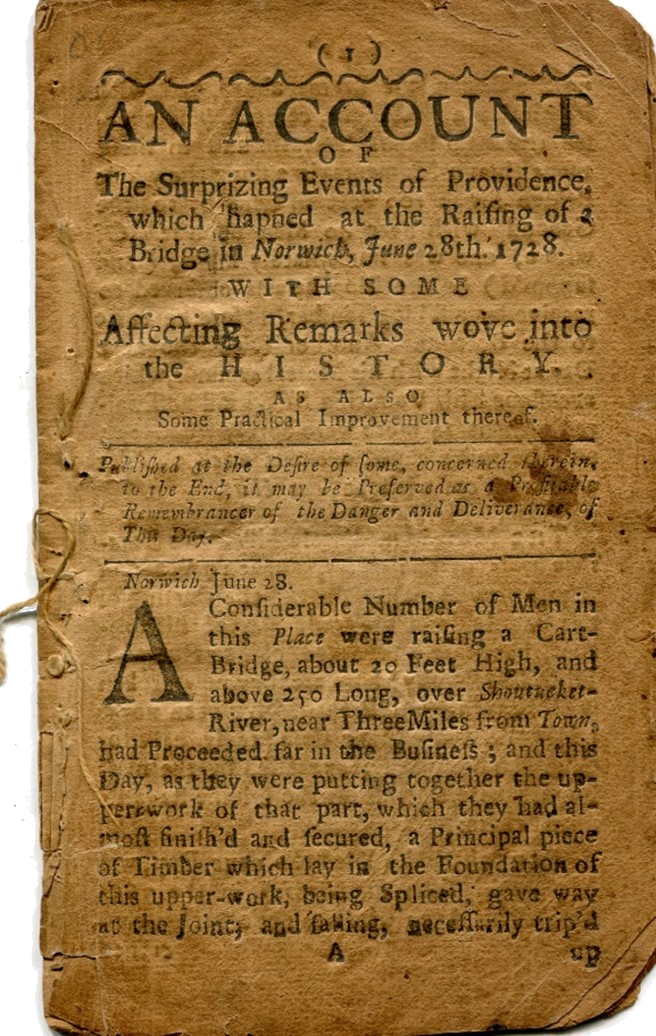 Pamphlet describing the 1728 collapse of the bridge over the
Shetucket River (Ring, 2011).
Pamphlet describing the 1728 collapse of the bridge over the
Shetucket River (Ring, 2011).

Jemima Walton died 18 September 1754 at about 54 years of age. The youngest Walton child, Miriam, was about 4 years old. Less than a year later, on 19 June 1755, Nathaniel, now age 58, married Hannah Smith, the 24-year-old daughter of Samuel and Sarah (Tracy) Smith of Norwich. Two years later, their first child, Anna was born. In the 24 years of their marriage, Nathaniel and Hannah (Smith) Walton had three children, two who survived to adulthood:
-
Anna Walton, born 25 June 1757 at Norwich, Connecticut (Norwich Vital Records, 1640-1834)[xii]; married Asa Culver, the son of Timothy and Mary (Lamb) Culver (Giorgi, 1984). Although she is named in her father’s will as “Anney Walton”, she is named in the administration of his will as “Anne Culver, 4th daughter, so she must have married Asa Culver after 5 October 1775 when Nathaniel wrote his will, and before 4 May 1779 when the will was probated. The Colver-Culver Family Genealogy (Giorgi, 1984) states that Asa Culver’s father, Timothy Culver and his second wife, Margaret “are both buried at Norwich Bridge Cemetery, Huntington [Massachusetts], with his younger brother Asa, his wife and children”[xiii]. The headstone of Asa Culver at Norwich Bridge Cemetery reads, “In Memory of Mr. Asa Culver he died 15 August 1804 in the 50 year of his age.”[xiv] (Massachusetts Death Records, 1841-1915). Based on Anna Walton’s recorded birth date in Norwich Vital Records, the age on her headstone is a few years off. She was actually 68 years old when she died, not 71, however this discrepancy is probably not significant. The 1875 Blandford, Massachusetts death record of Asa and Anna Culver’s daughter, Anna Gibbs, provides her parents’ names as Asa Culver and Anna Walton, which gives proof of Anna Culver’s maiden name (Massachusetts Death Records, 1841-1915).
-
Daniel Walton, born 27 February 1758 at Norwich, Connecticut (Norwich Vital Records, 1640-1834)[xv]; married 1) Zerviah Slafter about 1777, the daughter of John and Elizabeth (Handel) Slafter of Manfield, Connecticut and Foster, Rhode Island. (Barbour Collection, Pre-1850; Slafter, 1869)[xvi]. Daniel and Zerviah (Slafter) Walton had seven children together, born betweenn 1778 and 1791. On 12 August 1812, Zerviah Walton divorced Daniel for desertion and adultery and asked for a property settlement, which was granted (Knox & Ferris, 2022). Fifteen years later, Daniel married 2) Sabra Smith 8 October 1827 in Lisbon, Connecticut (Barbour Collection, Pre-1850)[xvii]. Zerviah (Slafter) Walton died 29 September 1831 and was buried at Read Haskell (also Read and Herskell) Cemetery (Hale, 1932-5). Daniel died 24 November 1845 and was also buried at Read Haskell Cemetery (Hale, 1932-5). Sabra (Smith) Walton died 19 September 1858 in Griswold, Connecticut (Hale, 1932-5). Her place of burial is not known. Both Zerviah and Daniel left wills, naming their seven children, and the children of Rebecca, who had died when Daniel wrote his will. Daniel bequeathed the 180-acre Walton family farm to his son Henry, the only child from his marriage to Sabra (Smith) Walton (Connecticut Probate Records, 1609-1999) .
-
Nathaniel Walton, born 1 April 1763 at Norwich, Connecticut (Norwich Vital Records, 1640-1834)[xviii]. He died before his eighth birthday, on 17 March 1771 at Norwich, Connecticut (Norwich Vital Records, 1640-1834)[xix]. He is probably one of the children originally buried at the Walton Family Cemetery; and in 1992, reburied at the Hopeville Cemetery.

On 29 March 1757, Nathaniel entered into a land transaction with his neighbor Stephen Johnson to purchase for 12 shillings the tract of land where Jemima was buried:
“Containing Twelve rods of Land Bounded as followeth and lying on the North End of a hill, Northeast from Sd Johnsons Now Dwelling House it being a Place where ye said Walton Improved for a Buring Plase and is bounded as followeth Beginning at a Stake with Stones about it from thence Runing three Rods West to a heap of Stones, thence running four rods north to a Stake with Stones about it thence Easterly three rods to a Stake with Stones about it from thence south four rods the first mentioned bound”
“…to have the Privilege of a Convenient Way for him Self his Heirs and Afsigns forever, to pafs to and from said Twelve rods of Land to the Highway without any Moleftation from my Self, my Heirs & Afsigns for Ever…” (Norwich Land Records)
Thus began the Walton Family Cemetery. The site has been listed on the State of Connecticut’s Register of Historic Places as “Walton Cemetery: Lily Pond Road”, one of seventeen structures or features in Griswold of historic significance. The Hale Cemetery Collection identified the location of the cemetery as “1/4 mile N.E. of house on Dorothea Urloff farm” (Hale, 1932-5). The Find a Grave website describes the location of the Walton Burial Ground as “North of Lily Pond Road off of Route 12, near the Plainfield line.” In his research of Griswold, Connecticut cemeteries, David L. Phillips provided the following description of the Walton Family Cemetery (Phillips, 1918):
“About a quarter of a mile northeast of the dwelling house on the Deacon Henry Johnson farm, now owned by Dorothy Ihloff, on a small plateau well within the bounds of the ancient Norwich Nine Miles-Square, are gathered among the scattered grove of pines, is a cluster of ancient graves known as the Walton Burying Ground, and here on what it supposed was once Walton land the Waltons laid their dead. About thirty graves can still be made out, marked by rude stone slabs gathered from the fields. For the most part these stones bear no marks of identification of those laid there; one, however reveals the grave of the wife of Nathaniel Walton, the brother of John the scholar, for, crudely hammered on the stone by an unskilled hand are crude characters which spell out the following inscription:”
"September Ye 18, 1758*.
Then Died Thee
Wife Nathaniel
Walton, Name
Jemima.”
*The Hale Cemetery Collection provides the same transcription of Jemima's headstone, but lists her year of death as 1754. Considering that Nathaniel married a second time on 19 June 1755 , the 1754 date is probably the accurate one.
Dorothea Ihloff appears in the 1920 and 1930 US Censuses for Griswold, Connecticut. In the 1930 census, her residence is listed as a farm on “The Old Road to Plainfield”. A home that clearly matches the illustration of the Deacon H. L. Johnson dwelling house in The History of Norwich is located on Lily Pond Road just north of the intersection with Haley Meadow Road. The Walton farmland and cemetery would be approximately ¼ mile northeast of this location.
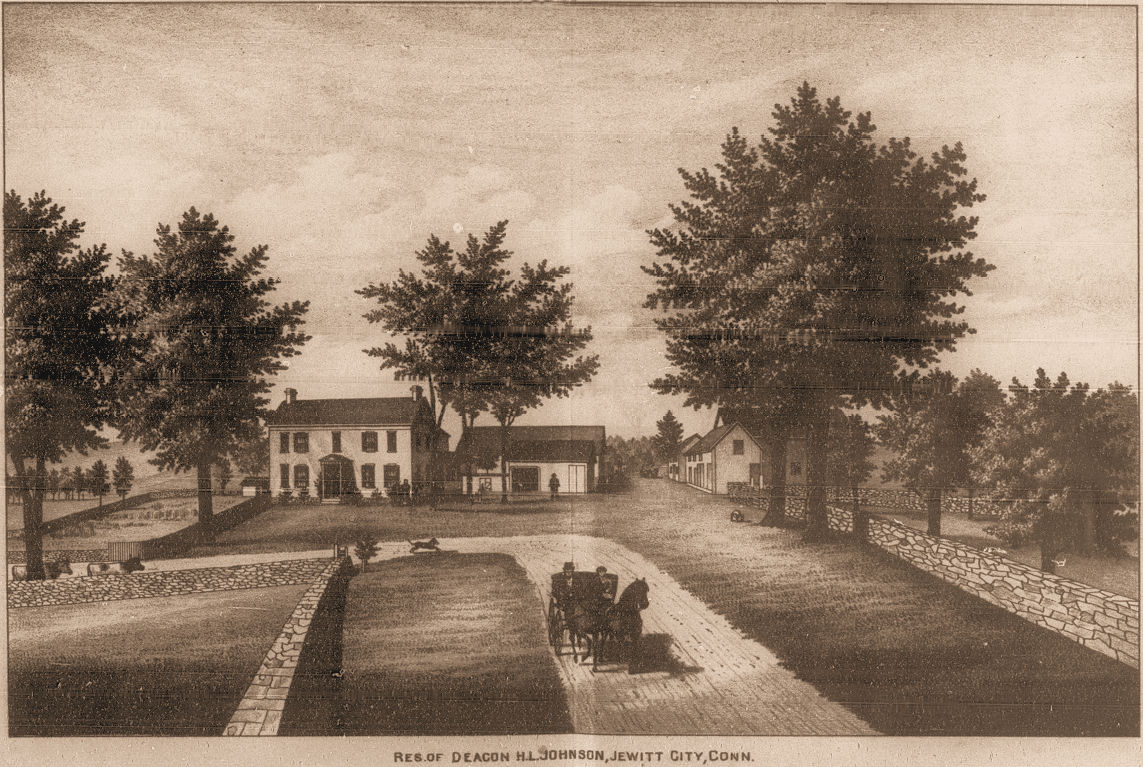
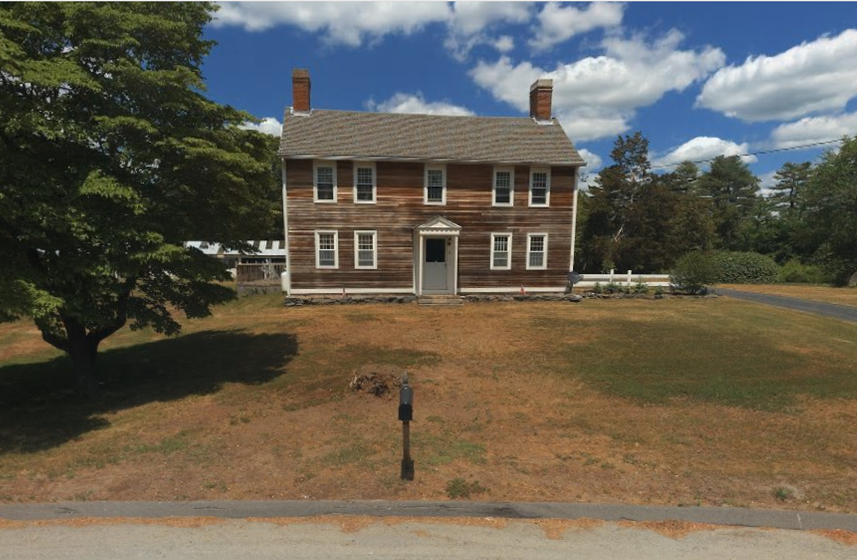
House on Lily Pond
Road which matches the front windows, entry and chimneys of the
illustration of the Deacon Henry L. Johnson residence

The Death of Nathaniel Walton
and
the Legacy of the Walton Family Farm and Cemetery
Nathaniel Walton died on 27 March 1779 (Griswold First Congregational Church, 1720-1810), just after his 82nd birthday. His will, written 5 October 1775, and probated 4 May 1779, named his children from his two marriages: sons Lawrence Walton and Daniel Walton, daughters Susannah Bennett, Jemima Heard, Miriam Williams, and Anna Walton, and the children of his deceased son, Joseph Walton. Both his wives, Jemima and Hannah, and his children Joseph, Anna, and Nathaniel predeceased him.
Nathaniel's youngest son, Daniel, and Daniel's mother (Nathaniel's second wife) Hannah (Smith) Walton were named co-executors of Nathaniel’s estate. However, Hannah died on 16 March 1776 (Griswold First Congregational Church, 1720-1810), leaving Daniel, who was then only 21 years old, as the sole executor. Nathaniel bequeathed to Daniel, “all my lands buildings thereon that is in Norwich”, which included 115 acres of land with buildings, valued at £4,000 (about $188,320 in 2023). This was probably “all ye land yt I have within the Township of Norwich or ever shall or Could have any right unto by any former purchas, or in Comon & undevidded Land, but especially ye farm that I now live on” granted in 1725 by Lawrence Walton to “my loving son Nathaniell Wolton” (Norwich Land Records, 1717-1727).
Daniel Walton died 24 November 1845 and was buried at the Read Haskell Cemetery (Hale, 1932-5), where his first wife, Zerviah (Slafter) Walton was buried. It appears that at this point, and perhaps sometime after Nathaniel Walton's death in 1779, Walton family members were no longer using the family burial ground. Daniel Walton bequeathed the now 180-acre Walton family farm to his youngest son Henry, the only child from his second marriage to Sabra (Smith) Walton (Connecticut Probate Records, 1609-1999) .
A review of census records shows that sometime between 1850 and 1860, Henry and his wife and children moved from Griswold to Plainfield, Connecticut, where he continued to farm. He may have sold the Walton family farm between 1850 and 1860 and purchased new land in Plainfied. A review of land records should confirm this. Certainly by 1870, Henry no longer was in possession of the Walton farm because he and his family were living in Norwich, where he was now working as a laborer. The 1873 and 1874 Norwich directories show he was employed as a teamster. By 1880, Henry (who was now going by his middle name David) was living with his wife and children in East Windsor, Connecticut.
Over the years, the precise location of the Walton Family Cemetery was essentially forgotten. Marked only with Jemima Walton’s crude headstone, and lacking any enclosing fieldstone walls or wood fencing, the burial ground eventually became concealed by the extensive overgrowth of vegetation. Because the Town of Griswold’s zoning code required title search only for the past 40 years of a property, the location of the Walton burial ground had not been verified (Bellantoni & Poirier, 1995) and the location was inaccurately shown on a 1917 map of Griswold cemeteries (Hanley, 1992; Libby, 1992).

Uncovering an Obscured Past
On a Sunday afternoon in November 1990, three 10-year-old boys were playing at H. David Geer’s sand and gravel pit. Today, Geer Sand and Gravel is located on 852 Voluntown Road, however this location makes no sense to the story that ensued. The 1990 location of the sand and gravel operation must have been the gravel pit located on Plainfield Road northeast of the intersection with Lily Pond Road, which is very close to the area described as the location of Lawrence and Margaret Walton’s farm. Aspinook Pond, a manmade embankment of the Quinebaug River, lies just to the northwest of this gravel pit. Lawrence Walton’s land bordered the Quinebaug River as described by land deeds relating to his farm.
In 1990, H. David Geer owned two parcels of land on Plainfield Road: a 2-acre parcel of land at 669 Plainfield Road, south of Lily Pond Road where it intersects with Plainfield Road, and a 10.57-acre parcel at 693 Plainfied Road, north of Lily Pond Road where it intersects with Plainfield Road (Griswold Town Assessor's Records; see blue outlined parcels in map below). This general location is consistent with the area described as the location of Lawrence and Margaret Walton’s farm. Aspinook Pond, a manmade embankment of the Quinebaug River, lies to the west of this area. Lawrence Walton’s land bordered the Quinebaug River as described by a 1725 land deed to his son John.
Bellantoni et al. described the location of the Walton Family Cemetery as situated,"on the north end of a sandy knoll, northeast of the Johnson dwelling", noting that the Hale Collection of Connecticut Cemetery Inscriptions incorrectly "showed the cemetery location on a different hill east of the knoll and across a swift-flowing brook from where the cemetery was subsequently rediscovered" (Bellantoni et al., 1997). Havey Brook, perhaps the swift-flowing brook, is located to the northeast of the map below, so the actual location of the Walton Family Cemetery most likely was within the blue outlined property at 693 Plainfield Road. Part of this property is northeast of the Johnson family dwelling house.
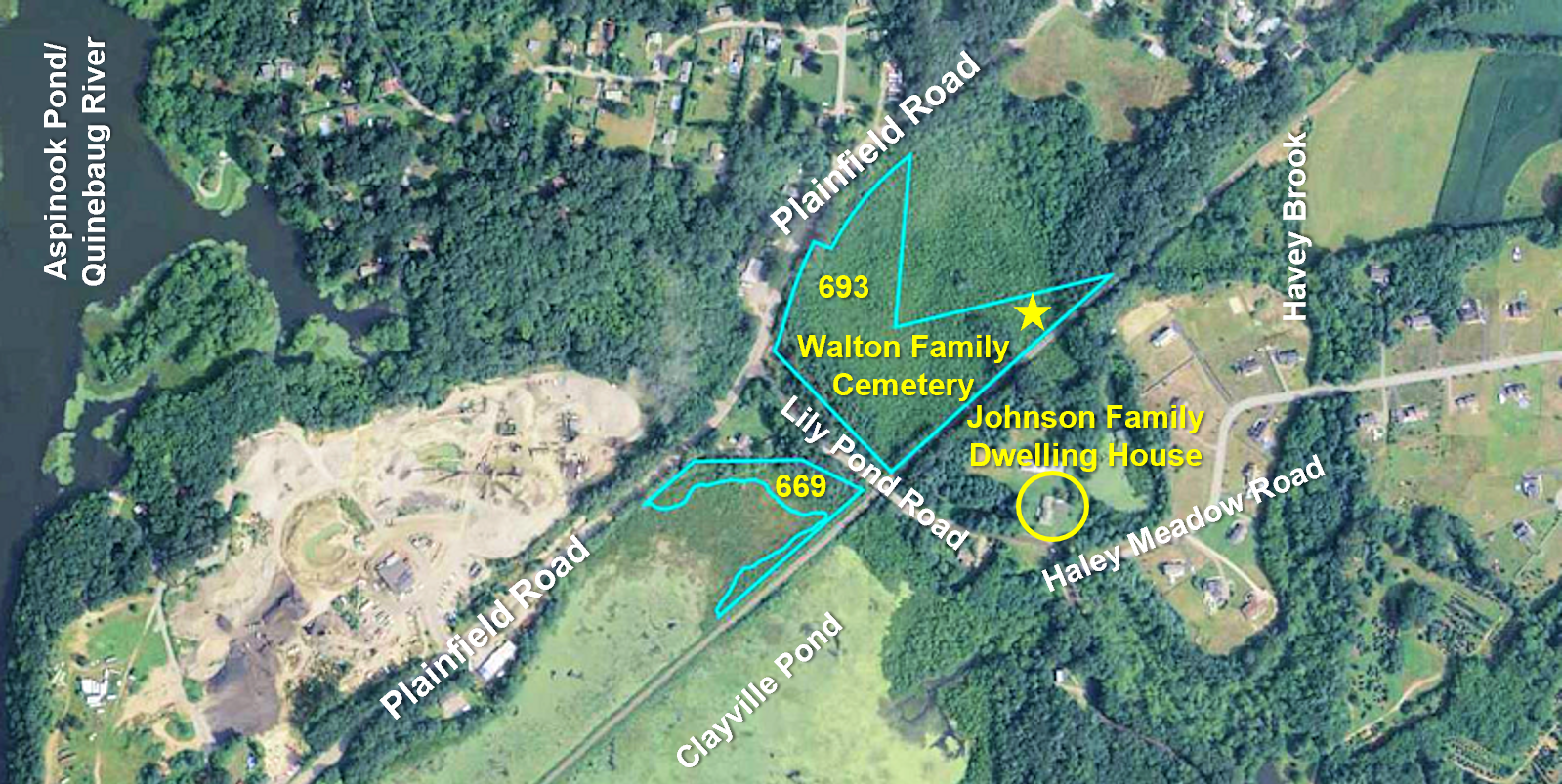
Map of the most likely location of the Walton Family Burial
Ground
(Map: Griswold Town Assessor's Records; additional labels
added)
The three 10-year old boys were having fun sliding down the steep embankment of the gravel pit, until two human skulls dislodged from the eroding slope and tumbled down the embankment with one of the boys. He went home and told his mother, returning at one point with the skulls, after which his mother notified the police. After criminal activity was ruled out, the State of Connecticut Archeologist Nicholas Bellantoni was brought in to examine the situation. He recognized signs of six burial shafts and realized they had encountered the first row of an old colonial graveyard which, according to a 1917 map, was supposed to be located on the opposite side of a stream near the gravel pit, and not in the vicinity where H. David Geer was excavating (Hanley, 1992). The instability of the sand and gravel bank precluded bank stabilization and preservation efforts to protect the graves at the very edge of the bank. Bellantoni’s efforts quickly became a rescue operation. The plan was to remove the bodies, analyze them, research the history of the burial ground, conduct the required forensics, and then rebury the bodies in a safe place (Bellantoni, 2013; Bellantoni & Poirier, 1995).
Bellantoni sent two University of Connecticut students to the nearby town hall to research the historical land use and ownership of this particular land parcel, especially during the 18th century. They found a copy of the 29 March 1757 land deed in which Nathaniel Walton purchased the land from Stephen Johnson and this connected the Walton family to the ancient burial ground (Bellantoni, 2013; Libby, 1992; Warneke).

Remembering a Forgotten Family
The archeological investigation revealed 29 graves containing six adult males, eight adult females, and l5 children and infants. All but three were determined to be members of the Walton family who used the cemetery until the early 1800s and then abandoned it as family members moved from the area. The cemetery was then used by another, unidentified family until about 1830 and then abandoned again.
Most of the bodies were laid out in a classic colonial Christian manner: on their back in a supine position with arms crossing, placed in an east-west direction with the head to the west, so as the body lays in the ground it faces the east, buried in a linen shroud held together with two pins, with no clothing or funerary objects, and placed within a wooden, hexagonal coffin (Bellantoni, 2013).
Three of the remains were determined to be from the other unidentified family, buried later, each buried in coffins with brass tacks which spelled the initials and age at death of each person, an adult male with inscription JB-55; an adult female with inscription IB-46, and a male child with inscription NB-13. One of these coffins containing the complete skeleton of an adult male, JB-55, had been arranged in his coffin in a very uncharacteristic way for colonial Christian burials that completely puzzled the archeological team: his skull and thighbones had been removed from the rest of his skeleton and placed in a “skull and crossbones” manner on top of his ribs and vertebrae, which were in disarray. Moreover, his skull was facing west, in direct opposition to conventional Christian burial (Bellantoni, 2013).
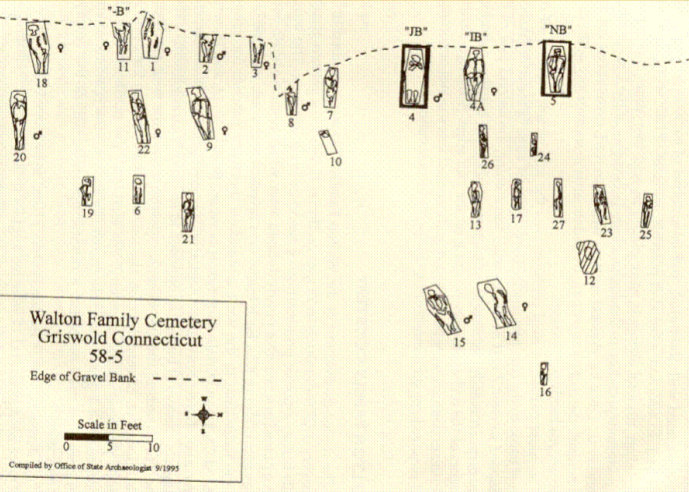
Bellantoni
Map of the Graves in the Walton Family Cemetery (Bellantoni, 2013)
The bodies were initially sent to the University of Connecticut for analysis, but then sent to Washington, DC to be studied with DNA analysis by scientists at the Smithsonian Institution and the Army Medical Museum at Walter Reed Hospital (Bellantoni, 2013; Libby, 1992).
One of Bellantoni’s responsibilities as the State of Connecticut Archaeologist was to notify possible descendants of the situation. He worked with the Griswold Historical Society and the Connecticut Genealogical Society to identify descendants of the Waltons who were eventually contacted in Massachusetts, New York, Maryland, Nevada, Arkansas, and California. The initial response from the descendants was distress that their ancestral family burying ground had been compromised and was imminently threatened by the sand and gravel mining operation. However, the archeologists were able to assure the descendants that their ancestors’ remains would be handled in a respectful and professional manner, that their input was a priority, and that the situation offered a unique glimpse into the lives of their 18th century ancestors (Bellantoni & Poirier, 1995).
A reburial ceremony was conducted in the fall of 1992 for the remains of the 25 Walton family members who had been archeologically rescued from their family burial ground. Historical research showed that the Walton family belonged to the First Congregational Church of Griswold. Walton family descendants from across the country attended as the Reverend Michael Beynon performed a traditional Puritan ceremony of reinterment at the nearby Hopeville Cemetery, contemporaneous with the Walton Family Cemetery. The remains of the 25 Walton family members were arranged in the manner they had originally been laid to rest at the Walton Family Cemetery, with the integrity of rows, body orientation, and relative positions re-established (Bellantoni & Poirier, 1995).
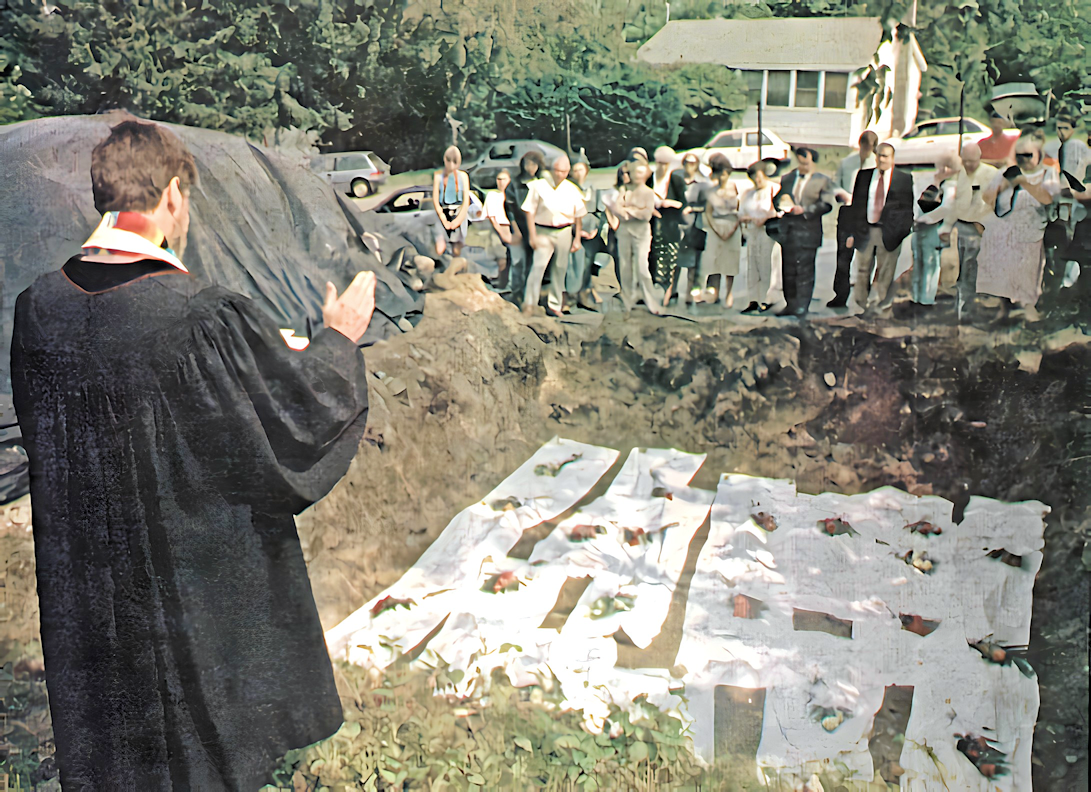
Reverend
Michael Beynon of the First Congregational Church of Griswold performs
the reburial service (Warneke).

Lessons Learned from a Difficult
Past
Study of the Walton family remains revealed some of the hardships of 18th century New England farm life. One of the most striking characteristics of the Walton Family Cemetery was the number of children and infants buried there. Half of the graves belongs to children under the age of 13, providing evidence that in the colonial era, parents could expect to lose one-third of their children before adulthood. In one, area seven Walton children were buried in a cluster. It’s believed these children may have died during the measles or smallpox epidemics which swept the area in 1759 and 1790 (Bellantoni, 2013; Bellantoni & Poirier, 1995).
The pathological conditions observed in the burials from the Walton Cemetery reflect lives of hard physical labor on the farm, including osteoarthritis and an unhealed femoral neck fracture in an elderly female, salivary gland tumors and one case of particularly heavy dental calculus (Bellantoni, 2013; Bellantoni & Poirier, 1995).
Of particular interest was the skeleton of the 55 year old male, JB-55, who had been arranged in his coffin in a “skull and crossbones” manner. His remains revealed symptoms of a chronic pulmonary infection severe enough to induce rib lesions. These symptoms would probably have included coughing, expectoration of mucous, and aches and pains of the chest, which if not actually caused by pulmonary tuberculosis, would likely have been interpreted as consumption by 19th century rural New Englanders (Bellantoni, 2013; Bellantoni & Poirier, 1995).
A seldom discussed phenomenon of 18th and 19th century New England folklore were some of the explanations derived for conditions which couldn’t otherwise be explained, such as the vampire folklore belief about tuberculosis that predominated in eastern Connecticut and western Rhode Island. The New England vampire belief was based on a folk interpretation of the physical appearance of the tuberculosis victim and the transmission of tuberculosis. As implied by the name consumption, the disease caused sufferers to waste away (Bellantoni & Poirier, 1995).
It was believed that after death, the family member with tuberculosis would feed upon the living as long as the dead body in the grave remained undecomposed. This led to the practice of exhuming the body of a family member who had died from consumption and burning the heart to ensure surviving members of the family would not become victims on which the dead body could feed. It was determined that the body of JB-55 was exhumed about five years after his death and by that time his internal organs had completely decomposed. It was hypothesized that in the absence of a heart to be burned, the remedy was to place his bones in a “skull and crossbones” arrangement to ensure he caused no further harm to living family members (Bellantoni, 2013; Bellantoni & Poirier, 1995).
It should be noted here that none of the Walton family members exhibited signs of tuberculosis, nor was there any evidence of the New England vampire belief among the Walton family. It was the disturbance of the Walton Family Cemetery that coincidentally shed light on the circumstance of JB-55’s burial. Evidence indicates that JB-15, IB-46 and NB-13 were not members of the Walton family and began using the Walton Family Cemetery for their family burials after the Walton family had abandoned the cemetery for their use (Bellantoni & Poirier, 1995).
In fact, Walton family members who still lived on the original Walton family farm no longer used the cemetery. It is likely that Nathaniel Walton, who died in 1779, was the last Walton family member buried there. As noted earlier, my 5th great-grandfather, Daniel Walton (1758-1845), a son of Nathaniel and Hannah (Smith) Walton, who inherited his father's farm in 1779, is buried at the Read and Herskell Cemetery in nearby Lisbon, Connecticut. Daniel Walton farmed the Norwich part of the original Lawrence Walton farmstead during his lifetime. Lawrence Walton bequeathed half of his farmland to his son Nathaniel Walton, who passed that land on to his son, Daniel Walton, who in turn passed it to his son Henry Walton. Possibly between 1850 and 1860, but certainly by 1870, Henry Walton appears to have sold the farm. Additional research of land records should reveal who the farm was sold to.
The remains of JB-55 were put through extensive DNA testing in an effort to identify him. Surname prediction was conducted from Y-chromosomal (patriarchal) DNA, resulting in two individuals who shared an almost identical profile to JB55. The surname Barber was listed for both individuals, a compelling result given the surname of JB-55 also begins with a “B” (Daniels-Higgenbotham, et al., 2019).
Historical records were searched by the Connecticut archeology team to determine whether there was a burial record for a J. Barber in Griswold, Connecticut in the early 1800s. A death notice in the Charles R. Hale Collection of Cemetery Inscriptions and Newspaper Notices listed a John Barber whose son Nathan Barber died in Griswold in 1826 at the age of 12. This death record closely matches the information on NB-13 who was discovered near JB-55 along with an adult female IB-46.
Although no further information has been found on John or Nathan Barber, 1810 and 1820 census records show a John Barber lived in nearby Canterbury, Connecticut in 1810 and 1820, with another, younger John Barber appearing in the 1820 census, possible a son of the other John Barber (Daniels-Higgenbotham, et al., 2019). An 1854 map of Griswold, Connecticut showing land ownership identifies the land of "Dr. S. Barber" in this same general area. This is probably Dr. Smith Barber, age 51, who appears in the U.S. Federal Census for Griswold with his wife Mary. There is no indication that he is related to the two John Barbers who appear in the 1810 and 1820 census listings for Canterbury.
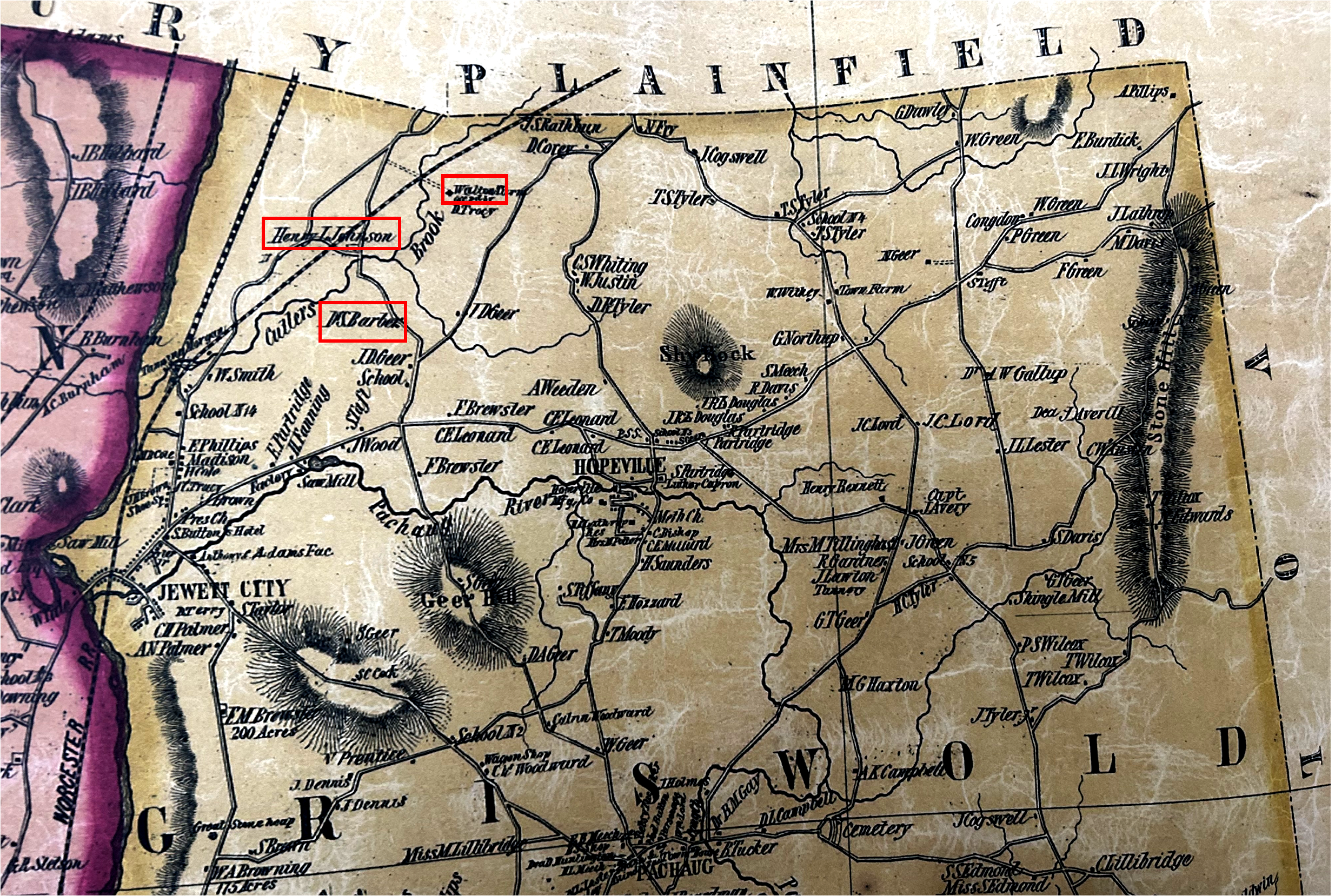
1854 Griswold
map showing location of Dr. S. Barber's land,
as well as the land of
Henry L. Johnson and what appears to be Walton land (red outlines).

My line of descent from Nathaniel and Hannah
(Smith) Walton down to my maternal grandmother is as follows:
-
Nathaniel Walton + Hannah Smith
-
Daniel Walton + Zerviah Slafter
-
Alice Walton + Squire Olin
-
Susannah Olin + Thomas Phillips, Jr.
-
Susan M. Phillips + Abel Burdick
-
Frank Rowland Burdick + Sarah Hannah Clark
-
Bertha Melissa Patterson
[i]
Volume 1, page 356; Image 452 of 590 on Family History Library
(FHL) Film # 007730763.
[ii]
Volume 2, page 53 ½; Image 554 of 973 of FHL Film # 007730319.
Some Internet family trees state her maiden name is Bennett,
however I have found no records to back this up.
[iii]
Memorial ID 117344580, URL
https://www.findagrave.com/memorial/117344580/lawrence-walton
[iv]
Volume 2, page 107; Image 447 of 973 of FHL Film # 007730319
[v]
Volume 2, page 114; Image 585 of 973 of FHL Film # 007730319
[vi]
Estate of Joseph Walton, Town of Norwich, 1754, No. 11166.
[vii]
Volume 2, page 114; Image 585 of 973 of FHL Film # 007730319
[viii]
Probate of the estate of Nehemiah Hunter of Norwich,
Connecticut. 1755.
No. 5506, Norwich Probate District.
[ix]
Volume 2, page 132; Image 459 of 973 of FHL Film # 007730319
[x]
Find a Grave Memorial ID 36195075. See
https://www.findagrave.com/memorial/36195075/isaiah-williams
[xi]
Find a Grave Memorial ID 36195808.
See
https://www.findagrave.com/memorial/36195808/miriam-williams
[xiii]
Page 63, Colver-Culver Genealogy.
Ms. Giorgi inaccurately referred to Asa Culver as the
younger brother of Timothy Culver, because she also lists him
as Timothy and Mary Culver’s youngest son.
[xiv]
Find a Grave Memorial ID 51568778.
See
https://www.findagrave.com/memorial/51568778/asa-culver
[xv]
Volume 2, page 176; Image 617 of 973 of FHL Film # 007730319
[xvi]
The birth dates of their children are given beginning in 1778
in Barbour, Town of Griswold, page 46 (referencing original
Griswold Town Records, page 8). The Slafter genealogy notes
the marriage of Zerviah Slafter and Daniel Walton but does not
give a marriage date.
[xvii]
Barbour, Town of Lisbon, page 234 (referencing original Lisbon
Town Records, Volume 1, page 80)
[xviii]
Volume 2, page 176; Image 617 of 973 of FHL Film # 007730319
[xix]
Ibid.

Sources
Barbour Collection. (Pre-1850). The Barbour Collection of Conecticut Town Vital Records.
Bellantoni, N. (2013, March 19). New England Vampire Folk Belief: Archaeological Evidence. A lecture sponsored by Quinnipiac University's College of Arts and Sciences. Hamden, Connecticut. Retrieved from https://www.youtube.com/watch?v=jiCKJBHdNgo
Bellantoni, N. F., Sledzik, P. S., & Poirier, D. A. (1997). Rescue, Research, and Reburial. In D. A. Poirier, & N. F. Bellantoni (Eds.), In Remembrance: Archeology and Death (pp. 131-154). Westport, Connecticut: Bergin & Garvey.
Bellantoni, N., & Poirier, D. A. (1995). Family, Friends, and Cemeteries. (N. P. U.S. Department of the Interior, Ed.) Cutural Resources Management, 18(1), 29-31.
Canterbury Vital Records. (1696-1820). Canterbury Connecticut Births, marriages, deaths. Volume 1 1696-1820, Family History Library Film #007730763.
Caulfield, E. (1937, March). Dr. John Walton, Yale 1720. Yale Journal of Biology and Medicine, 9(4).
Caulkins, F. M. (1866). History of Norwich, Connecticut from its possession by the Indians, to the year 1866. Published by the author.
Connecticut Probate Records. (1609-1999). Probate Files Collection, Early to 1880. (Ancestry.com, Ed.) Connecticut, Wills and Probate Records, 1609-1999.
Daniels-Higgenbotham, J., Gorden, E. M., Farmer, S. K., Spatola, B., Damann, F., Bellantolli, N., . . . Marshall, C. (2019). DNA Testing Reveals the Putative Identity of JB55, a 19th Century Vampire Buried in Griswold, Connecticut. Genes, 10(9), 636.
Find a Grave. (1995). https://www.findagrave.com/
Giorgi, V. D. (1984). Colver-Culver Family Genealogy. Santa Maria, California: Privately published by the author.
Hale, C. R. (1932-5). Hale Collection of Cemetery Inscriptions and Newspaper Notices, 1629-1934. Hartford, Connecticut: Connecticut State Lbrary. Hale, C. R. (1932-5). Hale Collection of Connecticut Cemetery Records.
Hanley, C. (1992, September 10). Descendents attend reburial of 25. Meriden Record-journal.
Knox, G. L., & Ferris, B. B. (2022). Connecticut Divorces: Superior Court Records for the Counties of New London, Tolland, and Windham, 1719-1910. Berwyn Heights, MD: Heritage Books.
Libby, S. (1992, February 16). Cemetery Holds Tales of Vampires. The New York Times, p. 119.
Massachusetts Death Records. (1841-1915). Massachusetts, U.S. Death Records 1841-1915. Ancestry.com.
Norwich Land Records. (1717-1727). Norwich Land Records, Volumes 3A-4, Family History Library Film # 5025; Image Group Number 8199223. Norwich, Connecticut.
Norwich Vital Records. (1640-1834). Norwich Connecticut Births, Marriages, Deaths 1640-1834, Volume 1, Family History Library Film # 007730319.
Phillips, D. L. (1918). Griswold Cemeteries. Historical and Descriptive Sketches of Twenty-two Burial Places in Griswold, Connecticut, and St. Mary's Cemetery in Lisbon, Connecticut, with Copies of all the Inscriptions on their Monuments.
Porter, G. S. (1985). A Genealogy, the Descendants of Lawrence Walton of Preston, Connecticut Circa 1693. Norwich: Privately Published. Available through the Genealogy Department of the Allen County, Indiana Public Library (reference only) and electronically through several public family trees on Ancestry.com.
Ring, R. (2011, November 8). The serendipitous discovery of COOL STUFF in the Watkinson. Retrieved from The Bibliophile's Lair: http://commons.trincoll.edu/watkinson/2011/11/08
Slafter, E. F. (1869). Memorial of John Slafter with a Genealogical Account of his Descendants, including Eight Generations. Boston: Henry W. Dutton & Sons. Warneke, J. (n.d.). Walton History in New England. Privately Published.
Warnecke, J. (n.d.). Walton History in New England. Privately Published.

| My Walton Ancestry |
| The Waltons of Preston, Norwich, and Griswold, Connecticut |
| Alice Walton of Griswold and Jewett City, Connecticut |
| Daniel Walton of Norwich, Connecticut |
| Nathaniel Walton of Preston, Norwich, and Griswold, Connecticut |
| Lawrence Walton of Preston, Norwich, and Griswold, Connecticut |

| Genealogy Home | My New England Ancestry | My Asia Minor and Pontic Greek Ancestry | Contact Me |
The oak leaf and acorn graphics on this page were made by me with a
commercially-made stencil, "Oak Trail". I prepared my own stencil
on watercolor paper and then scanned the
image and turned it into a transparent GIF.
The background paper for this page is from Ender Design's
Realm Graphics collection.
Last updated: Sunday, September 17, 2023 05:20:59 PM